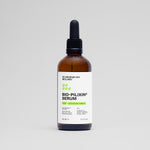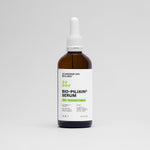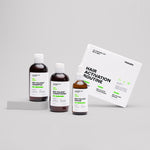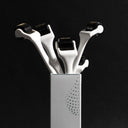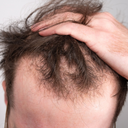A couple of years ago, we envisioned a hair activation serum that truly stands out from the crowd of hair loss products. We wanted to offer a holistic option to those affected by hair loss or thinning before they consider more drastic solutions such as drugs or invasive procedures. And we wanted to do it without compromising on the efficacy.
About 10 months, a 90-page clinical study, and countless prototypes later, our flagship Bio-Pilixin® formula was born, trusted by 95K+ customers today. In addition to our customers, we are also seeking to earn the trust of healthcare professionals and scientists, as the main criticism against hair loss products taking on a natural approach is the lack of scientific evidence.
That’s why having the results of the clinical study published in a recent issue of Euro Cosmetics Magazine was a significant milestone. Among many interesting insights, the study found that 93% of participants had a clinically tested reduction in hair loss after 150 days of using the Bio-Pilixin® Activation Serum daily.
In this article, we will uncover these findings to help you better understand the mechanism through which the formula works so you can make an informed decision. You can also take a look at the study itself if you prefer.
Table of content
A Common Link In Many Hair Loss Cases
Before we delve into the findings of the study, let's take a quick detour and examine what causes hair loss. After all, if we want to address a problem, we need to start by finding out what caused it.
It is common knowledge that several factors can cause and influence hair loss, including:
- Hormones
- Genetics
- Illness
- Medications
- Lifestyle factors (diet, stress…etc)
What is less commonly known is that any of these underlying factors may throw the delicate hair growth cycle out of balance, resulting in a shorter growth phase, premature shedding phase (and therefore excessive shedding), or hair thinning caused by follicular miniaturisation.
As your leading source for hair health information over the past 4 years, we never compromise on accuracy. When it comes to your health, you deserve information you can truly rely on - and earning your trust is our top priority.
Here's how Scandinavian Biolabs ensures every piece of content meets the highest standards of accuracy and integrity:
- Credentialed Experts: Our reviewers are actively practicing doctors and medical researchers
- Stringent Reviews: Content undergoes rigorous editing by subject specialists and review by a practicing doctor.
- Evidence-Based: We rely on well-established research from trusted scientific sources like peer-reviewed journals and health authorities.
- Full Transparency: Our editorial standards, writer credentials, reviewer credentials, correction process, and funding are all publicly documented.
- Independent Voice: While we do promote products, we operate in a vacuum to business operations. Our main goal is just an unwavering commitment to providing medically-sound guidance.
You can count on Scandinavian Biolabs to consistently deliver the trustworthy health information you deserve. Read our Editorial Standards.
A Key Step To Addressing Hair Loss
Since in many hair loss cases there is an imbalance in the hair growth cycle, re-balancing it can help reduce shedding and encourage growth (in addition to any other treatments that might be necessary).
Let’s take a closer look at how the hair growth cycle works and why it’s so crucial to maintain its balance.
The hair growth cycle has 4 phases (you may also see some literature discussing 3 phases only, considering telogen and exogen as one phase).
-
Anagen (growth): This is the period of active cell division and noticeable hair growth. Throughout hair cycles, about 90% of all follicles are in the anagen phase and can remain in this phase anywhere from 2 to 8 years.
- Catagen (regression): Over 2 to 3 weeks, cell production is halted, and the hair follicle shrinks. The hair shaft begins to separate from the bottom of the follicle and forms club hair.
- Telogen (resting): This phase is marked as the end of hair production as the follicle undergoes dormancy or cell quiescence. The follicle can remain dormant for up to 3 months with the hair club intact.
- Exogen (shedding): Coupled with the telogen phase, exogen is when the hairs fall out of the follicle, during which new hair begins to grow in the follicle as it returns to the anagen phase.
As mentioned above, normally about 90% of the hairs are in the growth phase at any given time. When the number of these actively growing hairs reduces and more hairs enter the resting and shedding phases, we start to lose hair at a more rapid rate than usual.
How We Target Hair Loss
The Bio-Pilixin® Serum was designed for individuals with various types of early-stage hair loss or those who desire to maintain hair volume.
To better understand how exactly the Bio-Pilixin® Serum helps reduce shedding and promotes growth, a team of researchers investigated the following experimental objectives on a cohort of 30 individuals for 150 days:
- The number of hairs in the growth and shedding phase
- The Effect of Bio-Pilixin® Serum on hair growth (hair density)
- The Effect of Bio-Pilixin® Serum on the reduction of hair loss
1. Number of hairs in the anagen and telogen phase
One of the most prominent aspects to consider when assessing products that promise to encourage growth is their ability to influence the anagen and telogen phases. Even though examining this is not always straightforward, it truly helps to unveil the potential of a product.
Since all factors that provoke hair loss, whether genetic or lifestyle-induced, may impact the delicate hair growth cycle, it makes sense to assess how products alter them.
In the clinical study of Bio-Pilixin® Serum, a trichogram was used to help determine the number of hairs in the anagen and telogen phases of all participants. A trichogram is a semi-invasive method that requires hairs to be extracted by the roots so that scientists can assess the hair bulbs by microscopy.

This process allows scientists to closely examine the hair bulb and determine which stage of the hair growth cycle the bulb belongs to.
The trichograms findings showed that 90% of the cohort demonstrated an average of 20% more hairs in the anagen phase after 150 days. Additionally, approximately 86% of the cohort demonstrated an average decrease of 40% in the telogen phase at the end of the study.
These numbers indicate that the Bio-Pilixin® Activation Serum is indeed able to support the normalisation of the hair growth cycle. Moreover, it does so optimising a natural process, without interfering with the body’s natural processes.
2. The Effect of Bio-Pilixin® Serum on the Reduction of Hair Loss
While examining the influence of Bio-Pilixin® on the hair growth cycle gives us insights into how effective the serum is, the above results may seem a bit abstract. So let’s take a look at some other aspects that are more visible to the user of the product.
First, let’s examine the effect of Bio-Pilixin® Serum on hair loss. To do this, volunteers underwent a wash and comb test in trichology. Under standardised conditions, individuals had their hair washed and combed during each clinic visit. All hair strands that fell during each process were saved and reported.
Notably, it was found that 93.3% had a measured reduction in hair loss after 150 days of daily use with a mean reduction of 52% of hair falling out compared to the first day of the study.

3. The Effect of Bio-Pilixin® Serum Hair Growth And Density
Now that we know how Bio-Pilixin® affects hair loss, it makes sense to also examine its influence on hair growth.
As mentioned above, the anagen phase of the hair growth cycle is normally quite long, and hair can stay in this growth phase anywhere between 2-8 years. Therefore, it is within the expectation that some months may pass before individuals can see major changes in their hair density or growth.
In the clinical study of Bio-Pilixin® Serum, hair density (the number of hairs per cm2) was assessed using a TrichoScan®, a software-based method used to determine hair density along with the status of hair roots of scalp hair.
Results showed that 77% of the participants had a clinically tested increase in hair density with an average increase of slightly over 8%. This may not seem like a lot, but with the average human head containing roughly 100,000 hairs, this 8% is equivalent to 8,000 hair strands expected to emerge over 150 days. While the hairs may be hardly noticeable, they are just starting to grow and should be given time to develop.

Conclusion
Hair loss can be caused by multiple factors including hormones, genetics, medications, illness, and lifestyle factors. But there is one common link among many of these cases: an undesired alteration in the hair growth cycle. While it is important to address any other underlying conditions that could contribute to the shedding, optimising the hair’s growth cycle is a key step towards fuller hair.
The findings of the study on our Bio-Pilixin® Activation Serum indicate that it can be an effective first step for those experiencing early-stage hair loss. It targets shedding by helping to re-balance the hair’s natural growth cycle and encourages growth without drugs.
References
1. Burg, D., Yamamoto, M., Namekata, M., Haklani, J., Koike, K., & Halasz, M. (2017). Promotion of anagen, increased hair density and reduction of hair fall in a clinical setting following identification of FGF5-inhibiting compounds via a novel 2-stage process. Clinical, cosmetic and investigational dermatology, 10, 71.
2. Houschyar, K. S., Borrelli, M. R., Tapking, C., Popp, D., Puladi, B., Ooms, M., ... & Duscher, D. (2020). Molecular mechanisms of hair growth and regeneration: current understanding and novel paradigms. Dermatology, 236(4), 271-280.
3. França, K., Rodrigues, T. S., Ledon, J., Savas, J., & Chacon, A. (2013). Comprehensive overview and treatment update on hair loss.
4. Geyfman, M., Plikus, M. V., Treffeisen, E., Andersen, B., & Paus, R. (2015). Resting no more: re-defining telogen, the maintenance stage of the hair growth cycle. Biological Reviews, 90(4), 1179-1196.
5. Higgins, C. A., Westgate, G. E., & Jahoda, C. A. (2009). From telogen to exogen: mechanisms underlying formation and subsequent loss of the hair club fiber. Journal of Investigative Dermatology, 129(9), 2100-2108.
6. Alonso, L., & Fuchs, E. (2006). The hair cycle. Journal of cell science, 119(3), 391-393.
7 Scandinavian Biolabs. (2022). A Clinical Efficacy Study of the BIO-PILIXIN® Formula Used in a Hair Serum.


